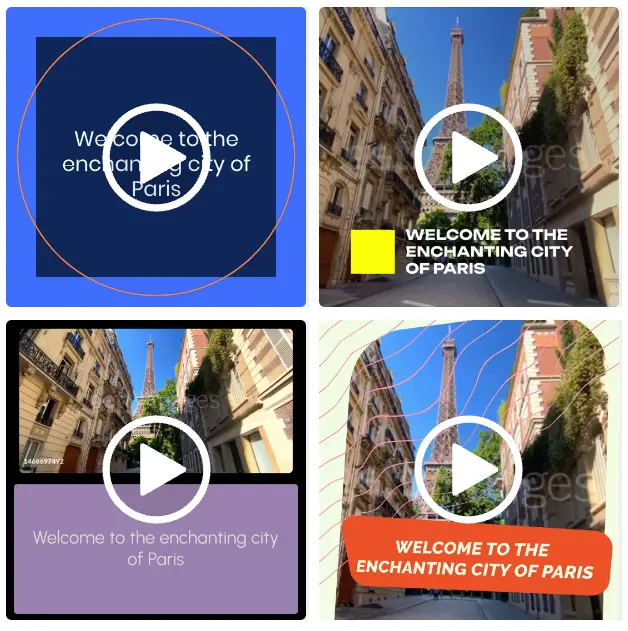Every year, new possibilities and advancements arise that we expect to redefine the way businesses connect with their audiences. This year will be no different and, with trend cycles happening faster and faster, businesses can’t afford to be static. Your success depends on not just keeping pace but staying ahead of the competition.
Ready to get caught up to speed? Let’s get into the must-know digital marketing trends of 2024.
AI Helps Video Expand Its Reach
First up? Video marketing expands its (already massive) reach. With platforms like TikTok and YouTube continuing to dominate, it’ll be hard to find a brand that hasn’t jumped on the video bandwagon and for good reason. Marketing is all about speaking to your audience and, for the modern consumer, video is the preferred language.
The real game-changer this year is the elimination of barriers to entry and you can thank AI for that. With help from AI video tools, businesses that once struggled to understand or afford video production can now effortlessly create compelling videos for their audiences.
For instance, our own AI video creator Lucas turns any text prompt into a video in seconds. Brands can use it to create anything from a promotional ad or an explainer video — no tech skills required. Here’s an example that Lucas made to look back on his first year.
For seasoned video marketing pros, AI tools are equally valuable, especially for boosting ROI. From being able to generate multiple versions of a video to enhancing video quality with a click, professionals are using these AI tools to streamline processes and scale up operations by creating more high-quality videos in much less time.
AI’s impact doesn’t stop there. AI-powered language tools are breaking down borders, allowing videos to reach a much bigger audience with features like real-time translated captions and dubbed audio. Take a cue from TikTok, where you can watch a video in a foreign language but still follow along seamlessly, thanks to auto-translated captions.
Social Platforms Become the Go-To Shopping Destination
When social media platforms first added shopping features to the experience, there was plenty of mumbling and grumbling about how social platforms have turned into a marketplace. Despite the criticism, the move has been a hit.
Social media giants like TikTok are leading the charge in transforming themselves into ecommerce hubs, blurring the line between social interaction and online shopping. In the U.S. alone, the short-form video app aims to grow its TikTok Shop by tenfold to $17.5 billion this year.
The appeal here is that users can now “shop where they scroll” without the hassle of leaving the app. Shoppable posts have become the new window displays, enticing users to not just like but also buy. Meanwhile, brands are leveraging the power of video to showcase their products, turning users from viewers into active consumers.
This seamless integration of ecommerce within social platforms not only caters to our desire for instant gratification but also facilitates enhanced hyper-personalization, making the shopping experience highly tailored and individualized.
Just like how TikTok’s For You Page algorithm can predict what videos we’ll enjoy most, we can expect TikTok Shop to present us with hyper-personalized product recommendations based on our recent interactions and activity.
Hyper-Personalization With Predictive Analytics
No longer is it sufficient to merely address your customers by their first names in emails. Today’s consumers crave experiences tailored to their unique preferences and behaviors. Here’s what the numbers have to say:
- 71% of consumers expect companies to deliver personalized interactions, with 76% getting frustrated when this doesn’t happen.
- Effective personalization can reduce customer acquisition costs by as much as 50%.
- Investing in advanced personalization can result in a return of up to $20 for every $1.
Love it or hate it, hyper-personalization is expected to be a required pillar in the consumer experience. And it’s not just about knowing your audience; it’s about predicting their next move before they even make it.
At the core of hyper-personalization lies predictive analytics, which involves analyzing past behaviors, preferences and interactions to anticipate what consumers want. By leveraging advanced algorithms, businesses can now predict customer needs and preferences with high levels of accuracy.
Successful examples of hyper-personalized campaigns are everywhere. Retailers are sending tailored discounts based on individual purchase histories, streaming services are curating playlists tailored to users’ music preferences and travel sites are suggesting destinations aligned with past travel behavior. In many cases, personalization is even being combined with the video trend mentioned earlier, through the use of Personalized Videos.
Overall, this approach is reshaping customer engagement, allowing brands to connect with their audience on a level that feels almost intuitive. Moving forward, successful marketers will be those who can deliver the personalized experiences that consumers crave.
More Crackdowns on Data Privacy
With all this talk about data-driven personalization, it’s necessary to discuss the legitimate concerns regarding data privacy. The fight for consumer privacy protection laws continues to gain momentum, with 7 U.S. states passing privacy laws in 2023 alone. For businesses, this means failure to comply will have greater consequences than before.
As users become increasingly aware of how their data is used, marketers must prioritize building trust through transparent data practices. It’s not just about complying with regulations; it’s about respecting your audience.
So how can marketers navigate this web of data privacy concerns?
First and foremost, be clear about your data practices. Communicate openly with your audience about what information you collect, why you collect it and how it will be used. Transparency builds trust and trust is the foundation of a long-lasting customer relationship.
Consider adopting technologies that prioritize user data protection. Embrace tools and vendors that not only comply with regulations but go above and beyond to safeguard consumer information. This not only protects your audience but also positions your brand as responsible with data.
For instance, Idomoo is ISO 27001 certified and SOC 2 Type 2 compliant, meaning our data security policies and practices have been assessed and approved according to stringent criteria.
Lastly, stay informed about the latest developments in data privacy regulations. The landscape is ever-changing and being proactive in adapting to new standards will not only keep you compliant but also demonstrate your commitment to respecting your audience’s privacy.
The Metaverse Continues To Grow
Spurred by the shift to online experiences during the pandemic, the metaverse made major headlines as the Next Big Thing a few years ago. Since then, the hype has died down in the press but certainly not in the ‘verse.
So what exactly is the metaverse? It’s essentially an interconnected virtual universe where users can engage in immersive experiences. Think of it as the next step in the evolution of the internet, where augmented reality (AR) and virtual reality (VR) become normal parts of the “online” experience.
Post on
Metaverse experiences have continued to grow steadily, most notably in gaming platforms like Roblox, Fortnite and Minecraft. For instance, branded Roblox games got 1.8 billion visits in 2023 and the number of monthly active users in the metaverse as a whole jumped 10.4% in the last quarter of 2023, from 549 million to 606.4 million.
While the metaverse has ways to go before being considered a mainstream channel, its influence is expected to get bigger and bigger as its users age. In 2020, for instance, 54.86% of Roblox daily active users were under 13 years old. Meanwhile, a survey of metaverse players found that players between the ages of 10 and 20 made up the largest percentage (38%).
For brands with younger audiences, including Gen Alpha, as their target audience, the metaverse is definitely where you want to be right now. For others, it’s a good time to get ahead by familiarizing yourself with this growing world. For more details, check out our guide to what the metaverse means for enterprises.
Real-Time Marketing Dominates
Real-time marketing is the art of engaging with your audience instantly by responding to current events, trends and consumer behaviors in the moment. It’s about being agile, adaptive and, above all, timely. In an era where attention spans are fleeting, real-time marketing allows brands to connect with their audience when it matters most.
More than ever before, brands are going to have to be able to move quickly. They’re going to have to craft and deliver content on the fly, aligning with the immediacy of consumers’ interests. Whether it’s leveraging trending topics or responding to live events, real-time marketing ensures that your brand is part of the ongoing conversation.
In adapting to this expectation, we can expect dynamic content to gain traction. Think Interactive Videos that evolve in real time based on user interactions or live data feeds. In other words, a single video can have infinite variations, allowing it to stay relevant and up-to-date, even as viewers, trends and more continue to change rapidly.
Not sure what that looks like? Check out the Living Video below, which updates its greeting according to who’s watching.
Learn, Adapt, Get Ahead
When it comes to digital marketing, things can move quickly. The good news? You’re as dynamic as the industry itself. The key is to embrace these shifts, stay informed and strive to be innovative. And if you’re eager for more insights, especially on video marketing, check out the 8 video marketing trends to watch in 2024.







